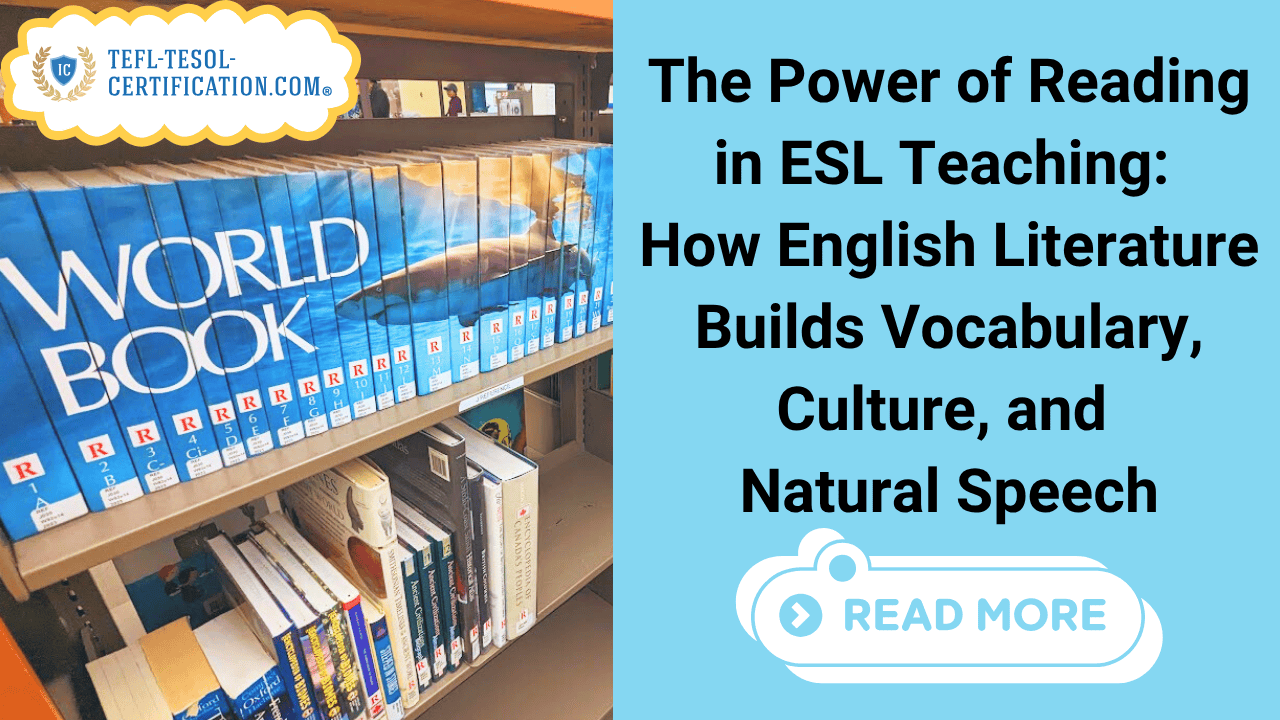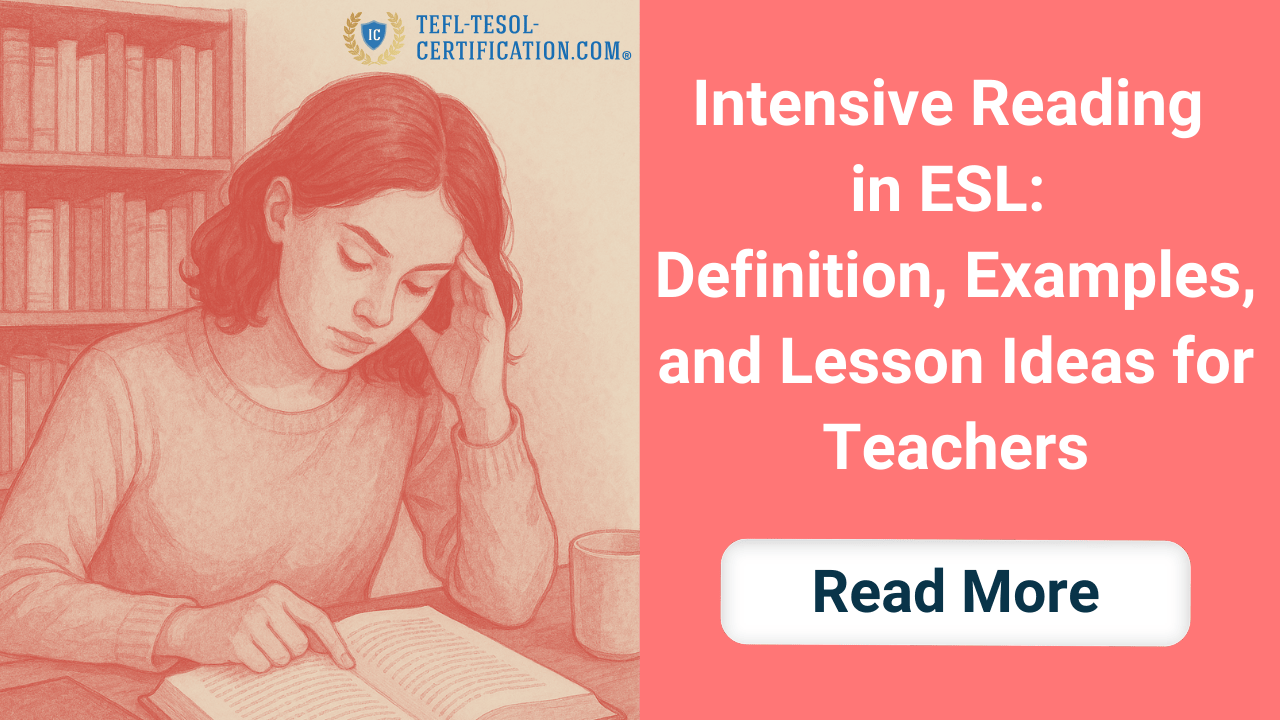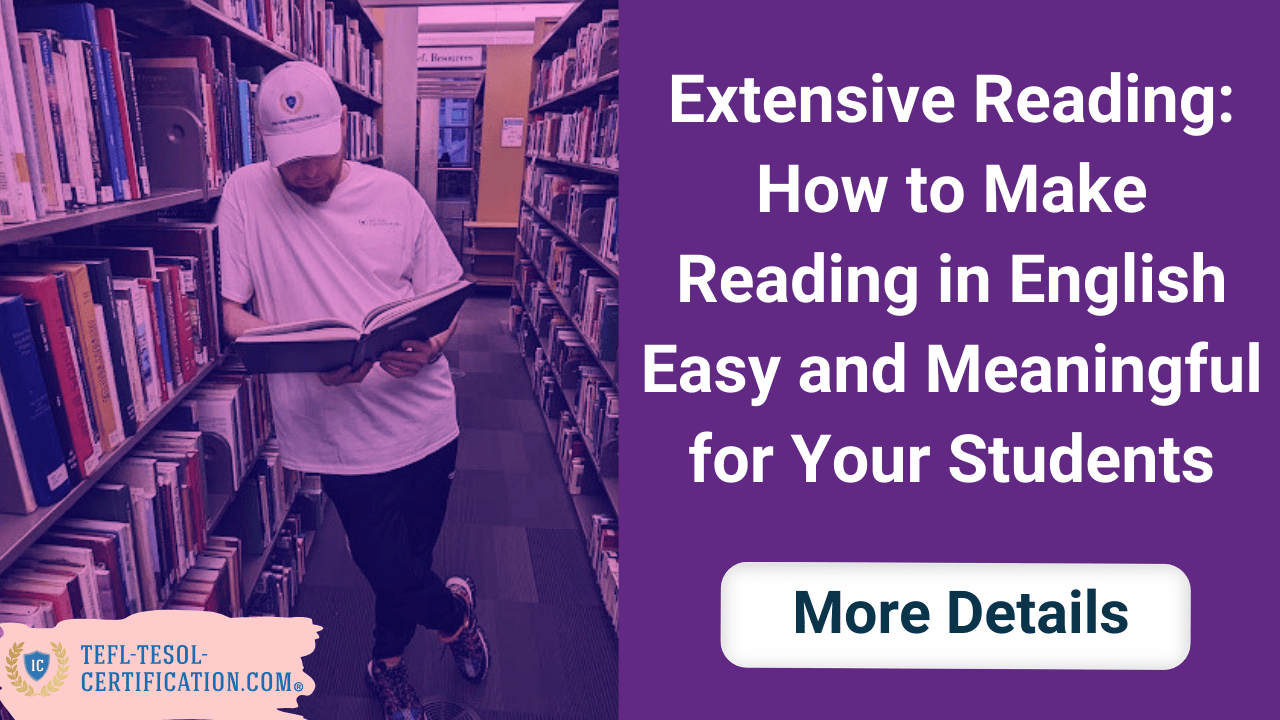Reading is exploration — a powerful tool that activates the brain areas connecting words with imagery, helping learners expand both their passive and active vocabulary while forming natural speech patterns. Numerous studies confirm that reading English literature for language learning is not just a pleasant add-on but a proven method that enhances fluency, comprehension, and emotional engagement in ESL classrooms.

The Power of Reading in ESL Teaching: How English Literature Builds Vocabulary, Culture, and Natural Speech
Table of contents
- English Literature in ESL Teaching: Why It Works
- Teaching Benefits: How Reading Literature Boosts ELT Practice
- How to Choose Books for ESL Students
- English Through Literature and Culture
- Teaching Methods: Extensive vs. Intensive Reading
- Genres and Language Growth
- Vocabulary Practice: Four Fast Tools
- Feedback and Assessment Made Simple
- Four-Week Reading Roadmap
- Common Mistakes to Avoid
- TEFL/TESOL and Literature: Why Certification Matters
- Three Lesson Scenarios for Any Level
- Final Thought: Read, Discuss, and Live the Language
English Literature in ESL Teaching: Why It Works
When students engage with authentic texts, reading goes beyond memorizing vocabulary lists. It develops sensitivity to tone, irony, and voice — turning words into living meaning. Fiction and other literary texts create a strong bridge between vocabulary and natural speech, between grammar and context, accelerating both active and passive language growth.
- Literature provides context: words are remembered through stories, not isolated lists.
- It trains scanning and skimming — crucial skills for academic and real-world reading.
- It introduces culture and values — the “why” behind language learning for life, not just exams.
Class moment: “— Can I check this word in the dictionary?” — “Try to guess from context. What does the character feel?” — Pause. “Angry… but trying to stay calm.” That’s reading comprehension in action: understanding not only the word, but its emotional and contextual use.
Teaching Benefits: How Reading Literature Boosts ELT Practice
Reading literature in English teaching supports vocabulary, grammar, pronunciation, and interpretation skills. Here’s what consistently works in classroom practice.
- Vocabulary: focus on word families, collocations, idioms, and phrases in real contexts.
- Grammar: conditional, modal, and tense structures appear naturally in texts.
- Pronunciation: use dialogue reading to practice intonation, pauses, and rhythm.
- Writing: retell scenes, write letters to characters, or short reflective essays.
- Critical thinking: “Why did the author choose this metaphor? How would you say it differently?”
Tip: Ask students to “hear” background sounds or “feel” the setting — sensory awareness ties meaning to words more deeply.
How to Choose Books for ESL Students
The key is choosing the right book for the right level and purpose. Here’s a simple guide:
- Goal: vocabulary expansion (e.g., travel, work, relationships), grammar focus, or cultural discussion.
- Level: for B1, choose clear, fast-paced narratives; for B2, more complex syntax and subtext.
- Format: use graded readers for fluency or authentic texts for depth.
- Length: short stories build confidence and motivation faster.
- Values: pick topics that resonate emotionally with learners — discussions will be more engaging.
Pro tip: Start with texts where 70–80% of the vocabulary is familiar — this ensures new words integrate naturally.
🚀 More students, 💰 higher income, 🌍 complete freedom! ✅ 112 verified platforms with top rates ⏳ Flexible schedule – work whenever and as much as you want 🎯 Simple requirements – start earning right away 💎 Boost your career and income by teaching students worldwide!
English Through Literature and Culture
Understanding English-speaking cultures is best achieved through literature. Books reveal politeness norms, humor, social codes, and historical context — all essential for mastering authentic communication.
- Communication: explore how characters argue, apologize, or thank — then turn it into role-play practice.
- Values: “freedom,” “boundaries,” “responsibility” — great topics for class debates.
- Context: cultural references, idioms, and settings make lessons feel alive and relevant.
Mini dialogue: “— Why doesn’t he say it directly?” — “In English, indirectness can be more polite. Let’s think of softer ways to make a request.”
Teaching Methods: Extensive vs. Intensive Reading
Extensive Reading — Flow, Enjoyment, and Exposure
Extensive reading means reading widely and quickly for general understanding. Assign 15–20 minutes of free reading at the start of class. No dictionaries — just context and intuition. Ask students to note five collocations or phrases that stood out.
Intensive Reading — Precision and Analysis
Intensive reading focuses on detailed analysis: vocabulary, grammar, subtext, rhetoric. Break down a paragraph, paraphrase it, and identify patterns or stylistic features.
- Combine both: 10 minutes extensive + 20 minutes intensive keeps lessons dynamic and deep.
- Technique: highlight three collocations, one grammar feature, one rhetorical device.
- Check understanding: “Explain why the character argued with their friend — one minute.”
Genres and Language Growth
| Genre | Vocabulary Focus | Classroom Activity |
| Short Story | Frequent collocations, conversational phrases | Retelling from another perspective; mini-dialogue |
| Essay or Literary Nonfiction | Abstract vocabulary, cohesive devices | Argumentative essay; paragraph structuring |
| Modern Novel | Idioms, synonyms, stylistic richness | Character mapping; discussion and debate |
Start with short stories — they’re compact, emotionally engaging, and help students feel progress quickly.
Vocabulary Practice: Four Fast Tools
- Collocation maps: place a word in the center (“risk”) and branch out: take a risk, at risk, risk-averse.
- Shadow reading: repeat short dialogues to build rhythm and pronunciation.
- Synonym ladders: big → large → enormous (focus on nuance and context).
- One-minute talk: summarize a scene aloud — this activates vocabulary in real time.
The goal is not memorization, but connecting each word to emotion, movement, and meaning.
And start earning money 💸 by teaching English in your own country, abroad, or online from anywhere on the planet! 🎁 Gifts and bonuses: professional support from your personal coach 🧑🏫 and job placement assistant 💼.
Feedback and Assessment Made Simple
Clear assessment builds confidence. Evaluate by categories: vocabulary (accuracy, appropriateness), grammar (control and variety), coherence (logical flow), pronunciation (intonation, rhythm), and comprehension (who, what, why).
- Formative feedback: short notes — two strengths, one suggestion.
- Self-assessment: reflection table: “what I understood / what confused me / what I’d ask the author.”
- Portfolio: “favorite quote — why — word of the day.”
Four-Week Reading Roadmap
Week 1 — Building Speed (B1)
- Choose a short story with 70–80% familiar words.
- Task: note 5 collocations, 1 rhetorical device; explain the plot in 60 seconds.
- Output: mini-essay (120–150 words).
Week 2 — Grammar in Context
- Analyze 1–2 paragraphs for tense, modals, and conditionals.
- Role-play conflict scenes.
- Output: “My 10 words of the week” list with examples.
Week 3 — Culture and Communication
- Focus on politeness, humor, body language.
- Hold debates: “What would you do?”
- Output: voice recording retelling the scene (pronunciation + rhythm).
Week 4 — Integration
- 15 minutes extensive + 25 minutes intensive.
- Project: “letter to a character” or “alternative ending.”
- Output: mini portfolio with quotes, collocations, and reflections.
Common Mistakes to Avoid
- Text too hard: students get lost in vocabulary. Solution: simplify genre and shorten texts.
- No interaction: reading without discussion kills engagement. Always add speaking tasks.
- Word lists only: isolated words don’t stick. Use collocations, gestures, and imagery.
- No culture: grammar without meaning feels empty. Discuss humor, values, and everyday behavior.
TEFL/TESOL and Literature: Why Certification Matters
A TEFL/TESOL certification equips teachers with essential methods: lesson planning, integrating reading with grammar, and designing activities that transform passive reading into real communication. If you aim to improve your classroom reading techniques and student engagement, professional training helps you turn literature into a dynamic tool for teaching.
- Learn how to combine extensive and intensive strategies effectively.
- Build lessons that merge analysis, creativity, and cultural awareness.
- Gain a recognized credential that supports your teaching career worldwide.
From experience: one of my students started reading short stories weekly — three months later, he gave his first English presentation confidently and without notes. That’s the power of contextual vocabulary.
💡 Unlock the secrets to doubling your teaching income with our exclusive checklist! 🎯 This checklist is designed for English teachers who want to 📈 attract more students and 🔥 keep them engaged for the long term.
Three Lesson Scenarios for Any Level
“Five Details” (15–20 min, B1+)
- Pre-reading: predict with 3 short questions (“Who’s involved?”, “What might happen?”).
- Reading: no dictionaries — rely on intuition.
- Output: list 5 story details + 3 collocations; share with a partner.
“Voices” (25–30 min, B2)
- Read a dialogue with attention to intonation.
- Record a line and give peer feedback.
- Output: create a new short scene reusing target vocabulary.
“Change of Perspective” (30 min, B1–B2)
- Retell the story from a secondary character’s point of view.
- Focus: 8–10 collocations + 1 grammar structure.
- Output: write a 150–180-word short essay using the criteria.
Final Thought: Read, Discuss, and Live the Language
Literature isn’t a bonus — it’s the heart of real English. Within it live words, rhythms, gestures, and meanings that make communication human. Blend extensive and intensive reading, add thoughtful tasks, and your students will start to think in English — not just study it. Reading makes language alive, and that’s what great teaching is all about.
Terms used:
EFL, ESL, TEFL, TESOL

York Fern
An English instructor with 12+ years of experience. I work for an online school and travel the world, teaching students from various countries, leveraging my TEFL/TESOL certification. Seeing the world's oceans, mountains, and cities with my own eyes has given me a profound appreciation for the importance of quality education and international communication.
and start earning by teaching English in your country, abroad, or online from anywhere in the world! Order the course with a 50% discount 💸 and receive as a gift the support of a personal coach 👨🏫 and job placement assistant! 🎁🚀 Hurry, limited spots available! 🏃♂️💨
💡 Unlock the secrets to doubling your teaching income with our exclusive checklist! 🎯 This checklist is designed for English teachers who want to 📈 attract more students and 🔥 keep them engaged for the long term.
🚀 More students, 💰 higher income, 🌍 complete freedom! ✅ 112 verified platforms with top rates ⏳ Flexible schedule – work whenever and as much as you want 🎯 Simple requirements – start earning right away 💎 Boost your career and income by teaching students worldwide!
choose us?



